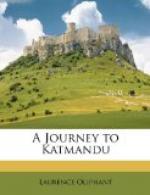Busreet and I went over the ladies’ apartments, which must have been very cheerless, since they are entirely composed of immense slabs of red sandstone and look hard and uncomfortable. Descending from them to the level of the court-yard, Busreet took me into a narrow sort of corridor, and jabbered incessantly for some minutes. I thought I could distinguish the words “hide and seek;” but it was so very unnatural to suppose that the only words of English Busreet knew were “hide and seek,” that I imagined he was repeating some Hindostanee phrase, until he dodged round corners and behind pillars, crying out as he did so, “Hide and seek! Hide and seek!”—from which I at last understood that he meant to inform me that the ladies used to play that Occidental game in Ackbar’s harem; so, after a short game to show the old man that I understood him, we strolled on to a singular kiosk-like little building, my guide every now and then renewing the game and hobbling round corners despite of my remonstrances to the contrary. The little temple was the residence of the holy man, and near it a room of most extraordinary construction astonished me not a little, since I could not divine its use, and Busreet afforded no information on the subject, as he pulled my head down and whispered something in my ear, which left me in doubt whether what he told me was a secret, or whether he meant to intimate that it was a whispering gallery: its real use I afterwards discovered.
In the centre of a square room was a pillar 15 or 16 feet in height, the circular top of which was six or eight feet in diameter and had been surrounded by a stone parapet; communicating with this singular pulpit-like seat were four narrow stone passages or bridges, one from each corner of the room. In each corner a minister of the realm used to sit, only one of whom might approach their royal master at a time. Seated on this centre point high above the heads of his subjects, who crowded the room below, and approached only by the four narrow causeways, the King deemed himself secure from assassination.
It was an original idea, and, after inventing so novel a method for guarding against treachery, he deserved to die in his bed, as in fact he did.




